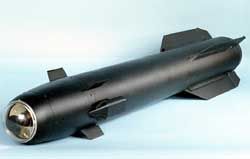Directorate Officer

Image Source: ttp://no.wikipedia.org/wiki/AGM-114_Hellfire#mediaviewer/File:Hellfire_AGM-114A_missile.jpg]here
Intent: To develop a way to deploy Sparkbee Honey on the battlefield
Development Thread: If necessary
Manufacturer: Lucerne Labs / Galactic Republic
Model: LLT-14 Duster-class Missile
Affiliation: Galactic Republic / Open Market
Modularity: No
Production: Mass-produced
Material: Plasteel fuselage, chemical propellant, various avionics, http://starwars.wikia.com/wiki/Plank_gas]Plank Gas, http://starwars.wikia.com/wiki/Sparkbee_honey]Sparkbee Honey
Classification: Chemical Weapon Dispersion Device
Size: Standard Starfighter-grade concussion missile
Length: 0.17 meters
Weight: 60 kilograms
Ammunition Type: Missile
Ammunition Capacity: 10 kilograms of pressurized http://starwars.wikia.com/wiki/Plank_gas]Plank Gas / aerosolized Sparkbee Honey (50/50 mix)
Effective Range: 1 kilometer
Rate of Fire: Single
Special Features:
Special Features:
-Dual Composite sensors
-area of affect gas attack (30 meter radius)
Strengths
-exceptionally accurate
Weakness:
-Overspecialized compared to other munitions
Description: The LLT-14 Duster-class Missile is chemical weapon dispersion device derived from the earlier LLT-7 Calmant-class missile. Like the Calmant, the Duster is designed to help counter the scourge of Vong technology that the Republic is facing. Unlike that weapon, the Duster is designed to explode via the use of proximity trigger to disperse noxious clouds of pressurized plank gas and sparkbee honey.
Like the Calmant, the Duster design is based on the standard concussion missile fuselage. This allows the missile to be fired from concussion missile launchers rather than requiring specialized launchers. The rear of the plasteel fuselage houses a simple, but highly reliable solid fuel chemical rocket optimized for maneuverability, not high speed like traditional concussion missiles; the designers believed tracking their target would be important that outrunning it. Because of this, the Duster has a maximum deployment range of 1 kilometer. This motor is guided by a dual-seeker target acquisition software using both millimeter-wave radar and uncooled imaging infrared sensors to form a composite image of the target and tracks it to the best of its abilities (this is a slightly less advanced version of the system used on the real life GBU-53, which also uses a laser to add a third sensor).Typically, this accuracy is to within a meter, thanks to the missile’s relatively slow speed, high maneuverability, and composite sensors. Under sensor jamming, the missile’s accuracy falls down to three meters. However, because of the aerial nature of its payload, this is still typically enough for the weapon to be effective. If the warhead is within four meters of its target, it detonates a small proton charge to disperse is gaseous payload all around it. Otherwise, the missile will still detonate on impact with a hard surface.
The gas containers inside of the missile contain Plank gas and aerosolized Sparkbee Honey. The plank gas is known for its high corrosivity. It can quickly eat away at armor or tissue. It is especially dangerous to living beings when it is breathed in, as it will eat away the lungs from the inside out. The other payload cannisters contain aerosolized Sparkbee honey, a frequent allergen to many Vong biots. With the plank gas eating away at organic tissue and armor of the target, the Sparkbee honey has a greater chance to make direct introduction into the target organism's body systems. Like the CSPL projectiles which originally fired plank gas, the Duster-class Missile has a blast radius of thirty meters. This makes it an area of effect weapon, and not one well-suited for close engagements, as the plank gas is usually dangerous to friendly forces as well.
While the Duster-class is primarily designed to be launched from starfighters and other small ships, the missile can also be adapted to be fired from standard handheld missile launchers like the PLX-2M with a little work. Because of the nature of the Vong threat, the Galactic Republic was able to buy production rights from Lucerne Labs to manufacture it on their own to speed up the production process. The GR typically issues the missiles to its troops that are likely to see action against the Vong. Lucerne Labs also sells the missile on the open market, though it has yet to sell any large orders to foreign governments or companies.
Primary Source: http://starwarsrp.net/topic/43463-calmant-class-missile/]LLT-7 Calmant-class Missile













